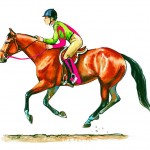
Ocala, FL (May 31, 2011) – Linda and Pat Parelli, the founders of Parelli Natural Horsemanship, Inc., recently returned from a successful European tour where they demonstrated their training techniques in front of sold out crowds. The couple also met with Olympic gold medalist and dressage coach, Klaus Balkenhol, who expressed his approval of the Parellis’ natural horsemanship training by bestowing upon them membership in the Xenophon Society. The society was founded to preserve and promote the classical principles of dressage, and the Parellis were thrilled with their induction as their training methods reflect the basic principles of classical training.
“Pat and I train with dressage Master Walter Zettl and Walter encouraged us to meet Klaus and his family while we were in Europe. We not only met them but I ended up going to their farm to show how our method helps with behavioral issues,” Linda said. “While we were still in Europe, Klaus made us members of the Xenophon Society which was a huge honor for us.”
The Xenophon Society is named for the famous Greek author of The Art of Horsemanship, an ancient manuscript that describes the proper care and treatment of the horse. Many of the points made by Xenophon are still considered relevant to horse training today, and the Xenophon Society was founded to uphold these ideas of ethical and classical equestrianism.

![Debbie McDonald_Brentina [PhelpsPhoto.com]](http://dressageradio.horseradionetwork.com/wp-content/uploads/2011/05/Debbie-McDonald_Brentina-PhelpsPhoto.com_.jpg)





